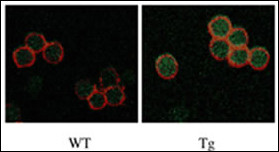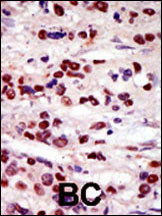DRAK2 Antibody (C-term)
Purified Rabbit Polyclonal Antibody (Pab)
- SPECIFICATION
- CITATIONS: 2
- PROTOCOLS
- BACKGROUND

Application
| IF, IHC-P, WB, E |
|---|---|
| Primary Accession | O94768 |
| Reactivity | Human, Mouse |
| Host | Rabbit |
| Clonality | Polyclonal |
| Isotype | Rabbit IgG |
| Calculated MW | 42344 Da |
| Antigen Region | 342-371 aa |
| Gene ID | 9262 |
|---|---|
| Other Names | Serine/threonine-protein kinase 17B, DAP kinase-related apoptosis-inducing protein kinase 2, STK17B, DRAK2 |
| Target/Specificity | This DRAK2 antibody is generated from rabbits immunized with a KLH conjugated synthetic peptide between 342-371 amino acids from the C-terminal region of human DRAK2. |
| Dilution | IF~~1:10~50 IHC-P~~1:50~100 WB~~1:1000 E~~Use at an assay dependent concentration. |
| Format | Purified polyclonal antibody supplied in PBS with 0.09% (W/V) sodium azide. This antibody is prepared by Saturated Ammonium Sulfate (SAS) precipitation followed by dialysis against PBS. |
| Storage | Maintain refrigerated at 2-8°C for up to 2 weeks. For long term storage store at -20°C in small aliquots to prevent freeze-thaw cycles. |
| Precautions | DRAK2 Antibody (C-term) is for research use only and not for use in diagnostic or therapeutic procedures. |
| Name | STK17B |
|---|---|
| Synonyms | DRAK2 |
| Function | Phosphorylates myosin light chains (By similarity). Acts as a positive regulator of apoptosis. |
| Cellular Location | Nucleus. Cell membrane. Endoplasmic reticulum-Golgi intermediate compartment. Note=Colocalizes with STK17B at the plasma membrane. |
| Tissue Location | Highly expressed in placenta, lung, pancreas. Lower levels in heart, brain, liver, skeletal muscle and kidney |

Provided below are standard protocols that you may find useful for product applications.
Background
DRAK2 is a novel serine/threonine kinase that induces apoptosis via catalytic activity. DRAKs present high sequence homology to DAP and ZIP kinases, and they represent a novel family of serine/threonine kinases. DRAK2 is located in nucleus, and the messenger RNA is ubiquitously expressed in human tissues.
References
Sanjo, H., et al., J. Biol. Chem. 273(44):29066-29071 (1998).
If you have used an Abcepta product and would like to share how it has performed, please click on the "Submit Review" button and provide the requested information. Our staff will examine and post your review and contact you if needed.
If you have any additional inquiries please email technical services at tech@abcepta.com.














 Foundational characteristics of cancer include proliferation, angiogenesis, migration, evasion of apoptosis, and cellular immortality. Find key markers for these cellular processes and antibodies to detect them.
Foundational characteristics of cancer include proliferation, angiogenesis, migration, evasion of apoptosis, and cellular immortality. Find key markers for these cellular processes and antibodies to detect them. The SUMOplot™ Analysis Program predicts and scores sumoylation sites in your protein. SUMOylation is a post-translational modification involved in various cellular processes, such as nuclear-cytosolic transport, transcriptional regulation, apoptosis, protein stability, response to stress, and progression through the cell cycle.
The SUMOplot™ Analysis Program predicts and scores sumoylation sites in your protein. SUMOylation is a post-translational modification involved in various cellular processes, such as nuclear-cytosolic transport, transcriptional regulation, apoptosis, protein stability, response to stress, and progression through the cell cycle. The Autophagy Receptor Motif Plotter predicts and scores autophagy receptor binding sites in your protein. Identifying proteins connected to this pathway is critical to understanding the role of autophagy in physiological as well as pathological processes such as development, differentiation, neurodegenerative diseases, stress, infection, and cancer.
The Autophagy Receptor Motif Plotter predicts and scores autophagy receptor binding sites in your protein. Identifying proteins connected to this pathway is critical to understanding the role of autophagy in physiological as well as pathological processes such as development, differentiation, neurodegenerative diseases, stress, infection, and cancer.



